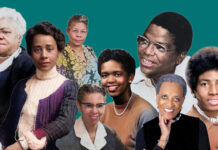 Christiana Best, an assistant professor of Social Work and Equitable Community Practice at the University of St. Joseph in West Hartford, Connecticut, takes a look at the persisting problem of hate crimes on college campuses. Dr. Best is a graduate of St. John’s University in Queens, New York. She earned a master of social work degree at the Silberman School of Social Work in New York City and a Ph.D. from the Graduate Center of the City University of New York.
Christiana Best, an assistant professor of Social Work and Equitable Community Practice at the University of St. Joseph in West Hartford, Connecticut, takes a look at the persisting problem of hate crimes on college campuses. Dr. Best is a graduate of St. John’s University in Queens, New York. She earned a master of social work degree at the Silberman School of Social Work in New York City and a Ph.D. from the Graduate Center of the City University of New York.Hate crimes or bias-motivated crimes on college campuses are on the rise today. But let’s not fool ourselves: students of color have always been plagued by crimes driven by racism – often relegating them to living in fear on the grounds of higher education institutions. As a college student, I knew there were some parts of my campus I couldn’t walk by myself after dark because I feared being taunted and subjected to racial animus and even worse – being attacked. As a first-generation college student, I had numerous issues and hurdles to navigate as part of my college career. However, concerns for my safety due to the color of my skin was not one I had anticipated when I applied to college, and neither do many of today’s college students. Colleges and universities are microcosms of American society. A society built to support and privilege some and exclude and marginalize others.
While racism is and has been a problem in the United States since its inception, the current political landscape has emboldened white supremacists to bully, intimidate and in some cases engage in acts of violence against the larger society and toward students of colors, as well as Jewish, Muslim and LGBTQ students, and their allies on college campuses. According to the Southern Poverty Law Center, there are 1,020 hate groups in America as of 2018, a 7 percent increase from 2017. The Anti-Defamation League recently reported that white supremacy propaganda increased 182 percent in 2018. According to the National Center for Education Statistics, of the hate crimes reported in postsecondary institutions in 2016, 38 percent were racially motivated; 21 percent were religious bias and 17 percent were sexual orientation bias. Yet, every fall, colleges and universities across the United States welcome students of color and other minorities to their campuses. Should young people – many of whom may face a lifetime of student debt – pay to be terrorized?
When students of color pursue higher education in order to make a better life for themselves and their families and they are subject to hate crimes and/or other inequities, who is responsible for their physical safety and psychological well-being? The federal government requires colleges and universities to report campus crime data, support victims of violence and publicly outline the policies and procedures they have put into place to improve campus safety. The question is, do racial hate crimes and violence get reported accurately?
Several studies have shown that hate crimes are violent acts that have the potential to cause traumatic stressors, potentially leading to anxiety, depression and other mental health concerns. Hate crimes are horrific forms of violence that target individuals because of their race, ethnicity, religion, disability, and sexual orientation, with the goal of instilling fear and undermining their sense of well-being. What is so insidious about hate crimes is that they are intended to communicate a message of hate, violence and “othering” – both to the targeted individual and their community.
Racist acts and hate crimes must be taken seriously and addressed immediately. Are colleges appropriately addressing these students’ trauma? A recent study found that cost and stigma were the most prevalent reasons why students do not seek mental health treatment. Moreover, are the counselors on campus trained to treat racial trauma? To add to these barriers, universities’ counseling offices are understaffed and racially under-represented.
Today’s college students are not submissive, nor are they tolerant of violence against them, the way I was. They recognize the sinister nature of racism in its various forms – microaggressions, patriarchy, structural racism, and white supremacy – and they are taking down names and documenting each incident. Today’s students are demanding safety, protection and accountability from their schools, administrators, politicians, and the country – telling us just what they need and deserve as U.S. citizens and students. They demand to be able to live and study in spaces free of violence. They are asking to recognize the trauma that comes with being hypervigilant and under constant stress due to bullying and violence (or the threat of them). Most of all, they are asking America – the land of the free and home of the brave, to see their humanity.










Christiana- Thank you again for another powerful reflection. Some Hasidic Jewish people in NYC said they were hiding by not clothing themselves for obvious targeting, I thought, how lucky to be able to do that. White supremacy helps with antisemitism.
This statistic is static and startling. We need to share it. Thank you again.
.”in 2016, 38 percent were racially motivated; 21 percent were religious bias and 17 percent were sexual orientation bias.”
Undoing Racism in our lifetime!
Thank you, Dr. Best! While media is reporting when all of the precipitating factors you accurately mentioned manifest themselves in violence of some sort, there is not enough reporting on organizations taking the actions necessary to combat factors in advance of that violence. Most colleges are reactionary to these factors. Students, parents, and America should demand more from our communities, counties, cities, states and more importantly, our elected representatives! Hopefully, articles like yours will foster the trends toward progress and preemptive actions!
Great post Dr. Best! This needs to be more recognized and acknowledged among everyone in higher education and our whole ecosystem to create more policy changes, intentional hiring, intentional events, and intentional investments to focus on underrepresented groups. Systemic and institutional anti-blackness persists along with anti-hate groups and continuously creating a space that puts the voices of people whom are underrepresented is needed. Thank you!
Thank you so much Dr. Best for this excellent post! It’s very important to keep this issue of racial injustice in the forefront and alive and your journalism is a means of taking action. History informs us that if we keep it a secret and don’t speak out against these atrocities, it will be repeated and re-enacted,
Education is a human right, how we advance ourselves and create a better life for ourselves. There is no place for hate crimes, violence and intimidation against anyone, minorities or ethnicities. Better policy and procedures, as well as accountability, need to be put in place to improve overall safety on our campuses. We look to our administrators and politicians to address hate crimes, Everyone has a right to feel safe while they get an education.